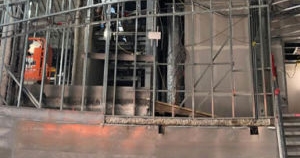Navigating potential pitfalls of an LED Display install is vital. Read further to discover ways to plan out how best to approach an install execution.
When designing, assembling, and integrating a large-format LED display, you are guaranteed to encounter some obstacles. While the hurdles you face in the design and assembly process will largely be tackled with physical solutions, the challenges of the execution portion of an install are often logistical. While manufacturers, audiovisual dealers, and systems integrators likely know this well, end-users or customers might be less experienced. Finding a manufacturer and integrator who understand the potential pitfalls of an install and is flexible enough to navigate them is vital to executing a project that performs reliably long into the future. Here are a few items to keep in mind as you plan out how best to approach an install execution.
Construction is Messy but Technology Doesn’t Do Well with Messy
For a manufacturer, there will always be the site-readiness idealism that your install will take place in an environment free of dust and debris. Sadly this ideal scenario rarely materializes so manufacturers and integrators will need to take steps to accommodate the crews operating around them and the contaminants these crews might create or leave behind. One such contaminant is concrete dust, which can be highly corrosive to the finer materials comprising an LED display. When administered in the form of shotcrete, which is a style of concrete that is shot from a pump, airborne dust particles can scatter throughout the entire built environment. Evaluations of the installation environment will need to be performed to ensure that once the integration of the display hardware begins, the air is clear of such corrosive particles. Other generic debris can include dust particles stirred into the air by the bustle of construction and organic material like pollen brought into the space by workers or guests.
Clearing the Air and Keeping Clear of Debris
Waiting for the air to clear can often take several hours, which means that the integration process of a display may not be possible during traditional work hours so crews may have to work through the night. Though tiring, an added advantage of such scheduling is that the environment will almost certainly be clear of guests or other crews. Of course, once the process is underway, the display will need to be protected from contaminants once guests and other crews return. This can involve wrapping the entire display integration operation in plastic to ensure there will be no debris ingress. This is a time consuming but highly necessary element of installation projects taking place alongside other construction – corrosive particles entering the tiny cracks in a display can dramatically reduce mean time between failures (MTBFs) and compromise an otherwise very durable system, potentially resulting in a finished display prone to failures, outages, or artifacts requiring higher rates of service calls. If you consider that most display technology is sold with a comprehensive parts warranty, the service warranty typically carries a cost-per-instance service level agreement, or T&E reimbursement at the very least – not to mention the distraction in the space. All of this can typically be prevented, assuming the technology manufacturer and integration project managers have the experience and training to identify these risky environmental challenges before they occur.
Coordinating with Crews is Crucial
As we’ve established, display installations are frequently not the only form of construction taking place in a given built environment. An organization might be overhauling an entire space, or even building new structures into which the display will embed. One recent Nanolumens project required the construction of an entirely new free-standing wall while our display was being mounted onto it. Even without other construction crews present, most large-format LED display integrations will feature teams from the manufacturer, the client, and the integration firm, not to mention the potential presence of consultants, architects, and content creators, let alone guests or customers! Each stakeholder will need to communicate what their needs are, where they can’t budge, and where they can. Finding manufacturing and integration partners who can coordinate flexibly and maintain strong working relationships with each other is vital to creating a clean and efficient integration environment. Cohesion across teams is worth investing in because if something goes awry in execution that requires input from separate companies, there need to be immediate protocols for who needs to fix what, what tools or materials they need, and when they can get to work.
You Didn’t Skimp on the LED Display Technology, Don’t Skimp on the Integration
We often mention how a display is only as good as the content that it shows, but this same sentiment can be applied to the display’s integration as well. If a product is installed in a messy, uncoordinated environment, its reliability and performance will diminish. This is an area where a client can really demonstrate their priorities. If you want an amazing solution, take the time to understand how best to achieve it.

